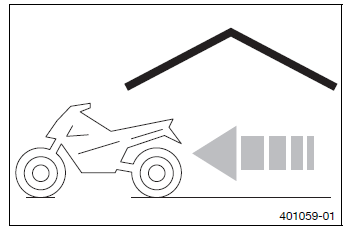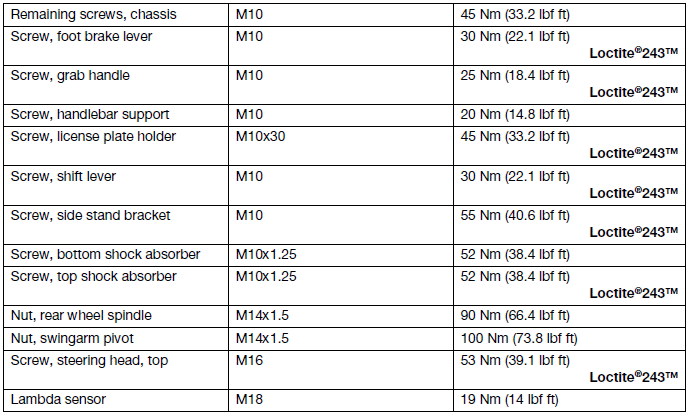 Husqvarna 401 Vitpilen - Owner's Manual > Storage
Husqvarna 401 Vitpilen - Owner's Manual > Storage
Info
If you plan to garage the motorcycle for a longer period, perform the following steps or have them performed.
Before storing the motorcycle, check all parts for function and wear. If service, repairs, or replacements are necessary, you should do this during the storage period (less workshop overload). In this way, you can avoid long workshop waiting times at the start of the new season.

- When refueling for the last time before taking the motorcycle out of service, add fuel additive.
Fuel additive
- Refuel.
- Clean the motorcycle.
- Change the engine oil and oil filter and clean the oil screens.
- Check the antifreeze and coolant level.
- Check the tire air pressure.
- Remove the battery.
- Recharge the battery.
Guideline

- Store the vehicle in a dry location that is not subject to large fluctuations in temperature.
Info
Husqvarna Motorcycles recommends raising the motorcycle.
- Raise the motorcycle with the rear lifting gear.
- Lift the motorcycle with the front lifting gear.
- Cover the vehicle with a tarp or similar cover that is permeable to air.
Info
Do not use non-porous materials since they prevent humidity from escaping, thus causing corrosion.
Avoid running the engine for a short time only. Since the engine cannot warm up properly, the water vapor produced during combustion condenses and causes valves and the exhaust system to rust.
Preparing for use after storage

- Take the motorcycle off the front lifting gear.
- Remove the rear of the motorcycle from the lifting gear.
- Install the battery.
- Set the clock.
- Perform checks and maintenance measures when preparing for use.
- Take a test ride.
Troubleshooting



Technical data
Engine


Engine tightening torques





Capacities
Engine oil

Coolant

Fuel

Chassis



Electrical system

Tires
Info
Hoses must be used in the tubeless tires on this vehicle.

Fork

Shock absorber

Chassis tightening torques







See also:
 Husqvarna 401 Vitpilen - Owner's Manual > Cleaning the motorcycle
Husqvarna 401 Vitpilen - Owner's Manual > Cleaning the motorcycle
Note Material damage Components become damaged or destroyed if a pressure cleaner is used incorrectly. The high pressure forces water into the electrical components, connectors, throttle cables, and bearings, etc.

 BMW G310GS
BMW G310GS Honda CBR125RW
Honda CBR125RW Husqvarna 401 Vitpilen
Husqvarna 401 Vitpilen KTM 890 Duke R
KTM 890 Duke R Mash Dirt Track 650
Mash Dirt Track 650 Peugeot Kisbee
Peugeot Kisbee Yamaha Tracer MT-09
Yamaha Tracer MT-09 Honda CBR125RW
Honda CBR125RW Peugeot Kisbee
Peugeot Kisbee Yamaha Tracer MT-09
Yamaha Tracer MT-09